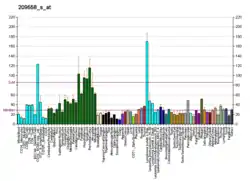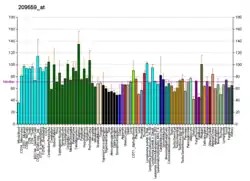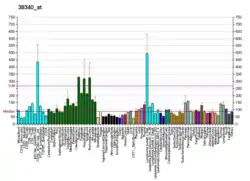HIP1R
Huntingtin-interacting protein 1-related protein is a protein that in humans is encoded by the HIP1R gene.[5][6]
References
- GRCh38: Ensembl release 89: ENSG00000130787 - Ensembl, May 2017
- GRCm38: Ensembl release 89: ENSMUSG00000000915 - Ensembl, May 2017
- "Human PubMed Reference:". National Center for Biotechnology Information, U.S. National Library of Medicine.
- "Mouse PubMed Reference:". National Center for Biotechnology Information, U.S. National Library of Medicine.
- Brett TJ, Legendre-Guillemin V, McPherson PS, Fremont DH (Feb 2006). "Structural definition of the F-actin-binding THATCH domain from HIP1R". Nat Struct Mol Biol. 13 (2): 121–30. doi:10.1038/nsmb1043. PMID 16415883. S2CID 1456946.
- "Entrez Gene: HIP1R huntingtin interacting protein 1 related".
Further reading
- Parker JA, Metzler M, Georgiou J, et al. (2007). "Huntingtin-interacting protein 1 influences worm and mouse presynaptic function and protects Caenorhabditis elegans neurons against mutant polyglutamine toxicity". J. Neurosci. 27 (41): 11056–64. doi:10.1523/JNEUROSCI.1941-07.2007. PMC 6672856. PMID 17928447.
- Bradley SV, Hyun TS, Oravecz-Wilson KI, et al. (2007). "Degenerative phenotypes caused by the combined deficiency of murine HIP1 and HIP1r are rescued by human HIP1". Hum. Mol. Genet. 16 (11): 1279–92. doi:10.1093/hmg/ddm076. PMID 17452370.
- Provençal N, Shink E, Harvey M, et al. (2005). "Analysis of a variable number tandem repeat polymorphism in the huntingtin interacting protein-1 related gene for anticipation in bipolar affective disorder". Prog. Neuropsychopharmacol. Biol. Psychiatry. 28 (8): 1299–303. doi:10.1016/j.pnpbp.2004.07.001. PMID 15588756. S2CID 23161289.
- Senetar MA, Foster SJ, McCann RO (2005). "Intrasteric inhibition mediates the interaction of the I/LWEQ module proteins Talin1, Talin2, Hip1, and Hip12 with actin". Biochemistry. 43 (49): 15418–28. doi:10.1021/bi0487239. PMID 15581353.
- Navarro-Lérida I, Martínez Moreno M, Roncal F, et al. (2004). "Proteomic identification of brain proteins that interact with dynein light chain LC8". Proteomics. 4 (2): 339–46. doi:10.1002/pmic.200300528. PMID 14760703. S2CID 8868600.
- Engqvist-Goldstein AE, Zhang CX, Carreno S, et al. (2004). "RNAi-mediated Hip1R silencing results in stable association between the endocytic machinery and the actin assembly machinery". Mol. Biol. Cell. 15 (4): 1666–79. doi:10.1091/mbc.E03-09-0639. PMC 379265. PMID 14742709.
- Hyun TS, Rao DS, Saint-Dic D, et al. (2004). "HIP1 and HIP1r stabilize receptor tyrosine kinases and bind 3-phosphoinositides via epsin N-terminal homology domains". J. Biol. Chem. 279 (14): 14294–306. doi:10.1074/jbc.M312645200. PMID 14732715.
- Ota T, Suzuki Y, Nishikawa T, et al. (2004). "Complete sequencing and characterization of 21,243 full-length human cDNAs". Nat. Genet. 36 (1): 40–5. doi:10.1038/ng1285. PMID 14702039.
- Strausberg RL, Feingold EA, Grouse LH, et al. (2003). "Generation and initial analysis of more than 15,000 full-length human and mouse cDNA sequences". Proc. Natl. Acad. Sci. U.S.A. 99 (26): 16899–903. Bibcode:2002PNAS...9916899M. doi:10.1073/pnas.242603899. PMC 139241. PMID 12477932.
- Legendre-Guillemin V, Metzler M, Charbonneau M, et al. (2002). "HIP1 and HIP12 display differential binding to F-actin, AP2, and clathrin. Identification of a novel interaction with clathrin light chain". J. Biol. Chem. 277 (22): 19897–904. doi:10.1074/jbc.M112310200. PMID 11889126.
- Chopra VS, Metzler M, Rasper DM, et al. (2001). "HIP12 is a non-proapoptotic member of a gene family including HIP1, an interacting protein with huntingtin". Mamm. Genome. 11 (11): 1006–15. doi:10.1007/s003350010195. PMID 11063258. S2CID 19956774.
- Seki N, Muramatsu M, Sugano S, et al. (1999). "Cloning, expression analysis, and chromosomal localization of HIP1R, an isolog of huntingtin interacting protein (HIP1)". J. Hum. Genet. 43 (4): 268–71. doi:10.1007/s100380050087. PMID 9852681.
- Ishikawa K, Nagase T, Suyama M, et al. (1998). "Prediction of the coding sequences of unidentified human genes. X. The complete sequences of 100 new cDNA clones from brain which can code for large proteins in vitro". DNA Res. 5 (3): 169–76. doi:10.1093/dnares/5.3.169. PMID 9734811.
- Puigvert A (1976). "Caliceal urodynamics". Urol. Int. 30 (4): 282–96. doi:10.1159/000279990. PMID 1189126.
This article is issued from Wikipedia. The text is licensed under Creative Commons - Attribution - Sharealike. Additional terms may apply for the media files.








